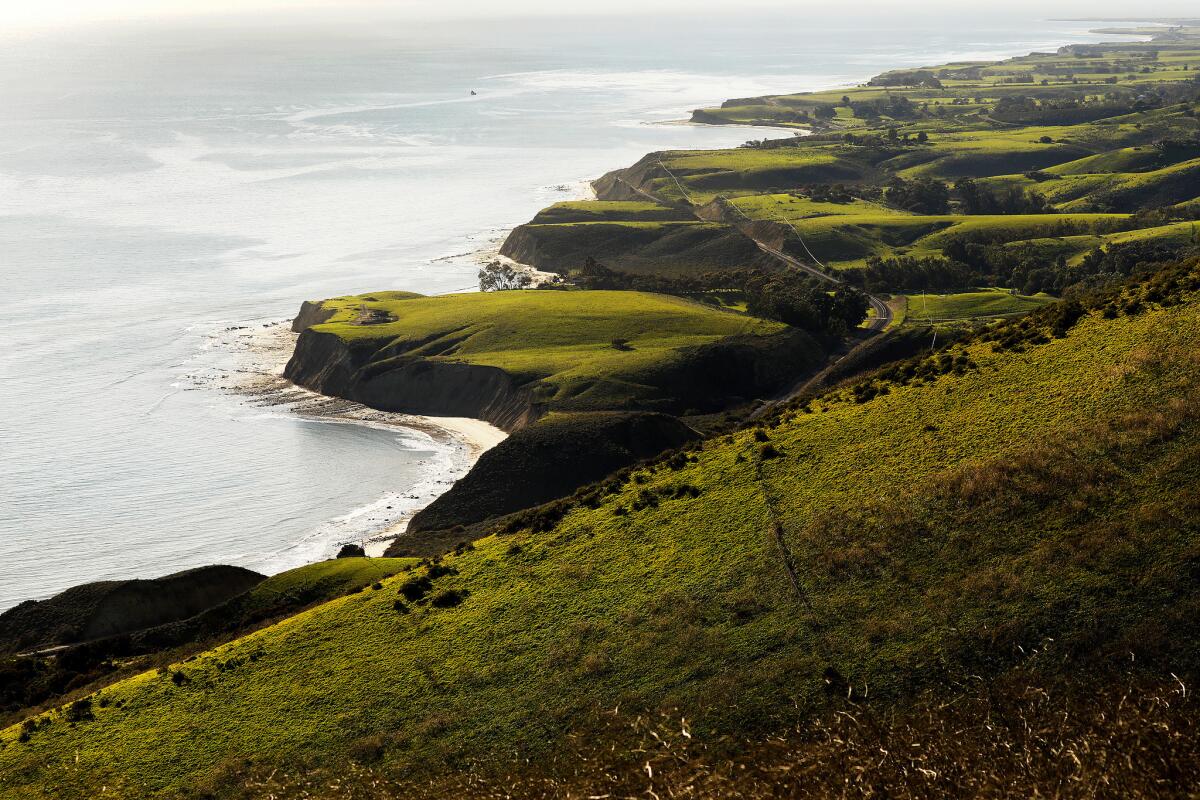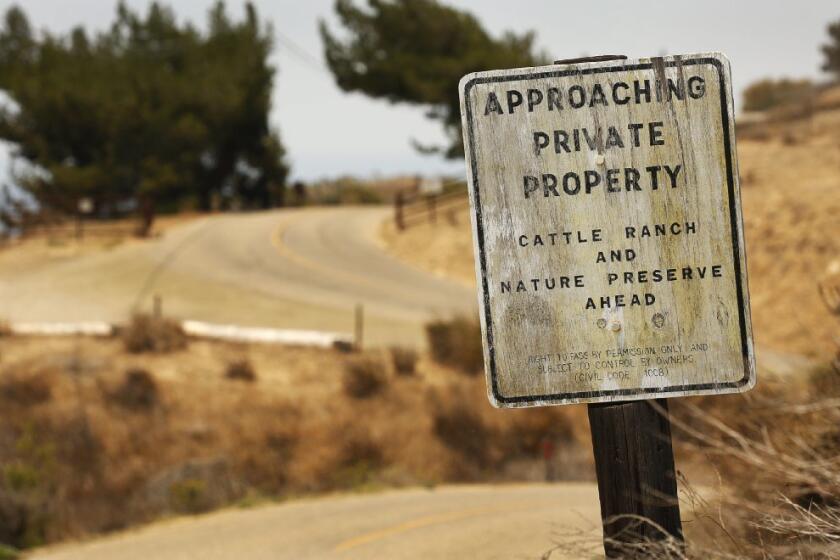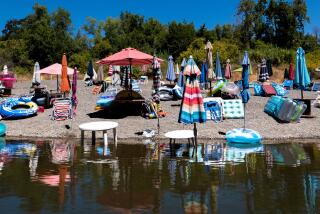Bill to open Hollister Ranch beaches to the public heads to Gov. Newsom. Will he sign it?

Drone flyover at one of the most pristine stretches of coastline in California —Hollister Ranch.
- Share via
The state Assembly gave final legislative approval Monday to a bill designed to open up the pristine beaches of Hollister Ranch, giving hope to advocates and officials whose efforts to secure public access have been thwarted for decades by the area’s powerful landowners.
Gov. Gavin Newsom has until Oct. 13 to decide whether to sign the measure, AB 1680, which requires that the public be allowed to enter the ranch by land and access some of its 8.5 miles of shoreline by April 2022. Further access would be phased in under a comprehensive plan to be developed in the next two years.
The bill also would make it a crime, punishable by tens of thousands of dollars in fines, for any action by a person or group “to impede, delay, or otherwise obstruct the implementation of “public access to these coveted beaches and surf breaks in Santa Barbara County.
A similar measure was rejected a year ago by then-Gov. Jerry Brown, who in his veto message called on state officials to work together on a new public access plan. Ranch owners, who have long contended that the little-trafficked stretch of coast has benefited from their private stewardship, celebrated that as a victory.
This year’s bill is stronger and more specific, lawmakers said, and the product of months of meetings and input from the agencies in charge of coastal access and staff from the governor’s office. Details of the final draft were made public just last week.
It cleared the state Senate on a 30-2 vote, and was approved by the Assembly, 69-1 — significant bipartisan support for an issue that has long pitted private interests against public rights.
“We have learned from the mistakes of the past,” said the bill’s author, Assemblywoman Monique Limón (D-Santa Barbara). “This bill comes after decades of other leaders ... attempting and failing — as well as our own attempt last year.”
It’s been four decades, she said, “We have to figure out a way.”
The state Coastal Act proclaimed in 1976 that the beach is for everyone — not just for those fortunate enough to own an oceanfront home. Officials over the years have chipped away at locked gates, private roads and neighborhoods that try to keep out the public. But at the ranch, a collective of owners has had the means to drag out the fight in court.
After years of litigation, coastal and ranch officials agreed last year to a controversial deal that would have allowed access only to landowners, their guests, visitors with guides and those who could boat or paddle in from 2 miles away.
The settlement sparked public outrage after The Times published terms of the deal. More than 2,000 people have emailed the commission — many of them worried that the ranch had found a way to keep the public at bay for good.
Monte Ward, president of the Hollister Ranch Board of Directors, said the ranch has been cooperating with state officials on recent initiatives and that several of the bill’s mandates are unnecessary or legally questionable.
“Despite our ongoing efforts to collaborate, we have largely been left out of the legislative process,” Ward said in a letter to Limón. “There are several provisions that seem to contravene the basic underpinnings of constitutional protections for private property, fairness, and due process.”

It is unclear where Newsom, in his first year leading the state, stands on this issue. He has not commented specifically on this bill or Hollister Ranch, but a spokeswoman for the state Natural Resources Agency said in a statement that, broadly speaking, “the Newsom administration is committed to coastal access for Californians.”
But Limón said the bill now on his desk fulfills Brown’s request and includes significant input from the California Coastal Commission, the state Coastal Conservancy, the State Lands Commission, California State Parks — as well as the Natural Resources Agency and Newsom’s deputy legislative secretary in charge of environment issues.
At one meeting last month, Limón said, there were 19 people at the table who had a say in the legislation now on the governor’s desk. She has met with ranch owners, who are also her constituents, and pushed the deadline back a year at their request.
Owners today include Patagonia founder Yvon Chouinard, musician Jackson Browne and filmmaker James Cameron. More than 1,000 other people also own a share of the ranch — many have worried what unfettered access could do to their years of work protecting the land.
In an agreement signed earlier this year, the agencies said they would work efficiently to expand and enhance “meaningful, safe, environmentally sustainable and operationally feasible public access to and along the coast at the ranch.”
To start, officials dusted off a plan created in 1982 establishing some baseline environmental studies and ideas that could still be used today.
That program included a walking trail and bicycle lane that would run parallel to the ranch’s main private road. To minimize the number of cars, a van would run from nearby Gaviota State Park to six Hollister beaches, where there would be picnic areas and bathrooms.

In July, about 20 officials from all four agencies, as well as the County of Santa Barbara, met with the Hollister Ranch Owners Assn. and toured the shoreline — yet another milestone in a standoff that in past decades had blocked state agencies from even entering the ranch.
They walked along the beaches and viewed picnic areas, restrooms, pathways and parking areas that have been used by owners and guests for years.
Surveyors from the State Lands Commission have also been allowed in to map the public beaches for the first time. And a consultant was recently hired to work on engaging the public as the state develops the access program.
The bill specifies that the ranch must continue to grant access to state officials as they work on the public access plan.
Dayna Bochco, chair of the Coastal Commission, acknowledged the ranch’s cooperation in recent months but said that given four decades of standoffs, having a law on the books for backup is certainly prudent.
“This bill goes to the specifics of what we need ... to achieve access for the public whether Hollister Ranch is willing to give it or not,” she said. “If they are willing to give it, the bill is not going to do anything different than what they say they’re willing to do. If they’re not willing to give it, then we have at least some resources on the books that allow us to do what is the fairest and the constitutional right of the public.”
The bill also rewrites a special section of the Coastal Act that has allowed ranch owners since the 1980s to pay a $5,000 fee in lieu of providing access whenever they sought a building permit.
Enforcement of that special section has come under scrutiny in the last year, with officials discovering that hundreds of thousands of more dollars could have been collected and that inflation had never been accounted for.
The fees were supposed to be used to provide access, but they had been sitting in a bank all these years. These funds are in limbo pending the outcome of the court battle.
The bill would now increase the fee from $5,000 to $33,000, adjusted annually for inflation. It also specifies that all “past, present and future” fees received must be deposited in an account to be used only by state officials to provide public access at the ranch.
It also instructs the Coastal Conservancy and States Lands Commission — which has legal authority to pursue eminent domain, land exchanges or negotiate boundary lines — to use their full authority to obtain public access “as expeditiously as possible.”

Bill supporters include about a dozen environmental advocacy groups, who welcomed the news on Monday and called on the governor to support beach access for all.
“If Gov. Newsom went to Hollister unannounced today, as a citizen with his wife and children, they would not be allowed in. That’s what makes this bill so incredibly important — not just for the governor but for all of the public,” said Susan Jordan of the California Coastal Protection Network. “The people who have been blocked from access for all these years deserve to finally get the chance to see the extraordinary coastline at Hollister Ranch.”
Jordan is also part of a coalition of nonprofits called the Gaviota Coastal Trail Alliance, which has been trying to stop the controversial settlement in court.
Outraged by a deal between wealthy landowners and state officials that bars the public from accessing Hollister Ranch by land, a coalition of activists on Monday took a final shot at opening a secluded stretch of the California coast.
In a ruling earlier this year, a Santa Barbara County Superior Court judge refused to approve the settlement and gave the coalition a chance to legally challenge the deal. Ranch lawyers responded by trying to disqualify the judge, questioning her impartiality and actions that they say have made her both “judge and advocate.”
The case is scheduled to go before the court again Sept. 23.
More to Read
Sign up for Essential California
The most important California stories and recommendations in your inbox every morning.
You may occasionally receive promotional content from the Los Angeles Times.













